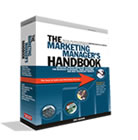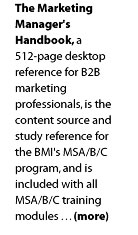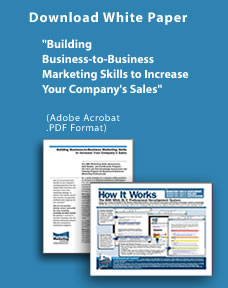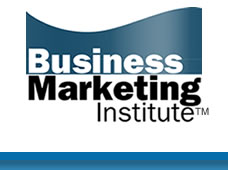


Tuesday Marketing Notes (Number 17—January 17th, 2006)
A B2B Marketing Newsletter for BMA Members
____________________________________________________________
MAKE SURE YOU CONTINUE TO RECEIVE EACH ISSUE OF TUESDAY MARKETING NOTES—CLICK HERE TO RENEW YOUR FREE SUBSCRIPTION
(NOTE: if you’ve already signed up previously at this link above, no need to do so again)

Special Savings Promotion for BMA Members—Click here . . .
Trade Shows
Part 3: Trade Show Deliverables: Using Clear and Effective Presentation to Draw Qualified Prospects to Your Booth
What do you want your company’s trade show appearances to do for your company?
As a marketing pro working on your next trade show, do you spend most of your planning time choosing between whether the next gimme you hand out in your booth will be logo-imprinted packs of LifeSavers, or logo-imprinted frisbees?
Or, did some Dilbert down the hall tell you to hire a couple of “show babes” to pose in front of your booth and smile emptily at the gawping hordes of lumbering show attendees?
These are the usual clueless ideas that most marketing pros get from kibbitzers when the topic turns to the action items for their company’s next big trade show appearance: Find a gimmick or a giveaway to draw people to our booth. And this is where conventional thinking is not only stupid, but interferes with you getting the best result from your trade show projects.
Your Job is to Draw Qualified Prospects to Your Company’s Booth
The objective for any trade show is to draw as many qualified prospects to your company’s booth as possible. Many marketers who think that traffic volume alone measures the success of a trade show will resort to various gimmicks, like giveaways, contests, or other distractions to draw as many visitors to their booth as possible. Marketers who use these tactics will draw more traffic to their booths, but will also tie down their salespeople, will be very busy trying to qualify unqualified freebie seekers, while the interested prospect stands there waiting for attention.
You’ll always be more successful in trade show promotion if you pay less attention to traffic-drawing gimmicks, and instead focus on the fundamentals of presenting your company and product in a clear, focused way, to communicate the essential facts about your product instantly to show attendees, so they can qualify themselves.
Unlike mailings, print advertising, or any other marketing project, at a trade show you can actually see how well your marketing deliverables draw qualified prospects to your company’s booth, by how they respond to your booth backdrop, signage, and the other deliverables you’re using in your booth space.
Trade shows are an exciting laboratory for seeing how real, live prospects respond to the positioning, sales copy approaches, and graphic layouts you’re using in your booth presentation. As a trade show producer, I’ve always looked forward to seeing show attendees’ reactions to my backdrops, signage, and booth videos, and I learn something new at every show.
The fundamental principles I’ve been covering, of using clear, obvious, salesmanship-oriented presentation in your ads, Web sites, sales copy and other deliverables are just as important for the trade show projects you produce.
But when producing deliverables for a trade show, it’s critical for you to know the function of each element of your booth space, how to use them to draw qualified prospects to your booth, and how to make them work together to generate solid sales leads from qualified prospects, and new business opportunities for your company’s sales team.
How Show Attendees Wander a Trade Show—and How to Get Them to Your Booth
One of the most important things a B2B marketing manager (or agency pro) can do is to put themselves in the place of the average, semi-disinterested prospect for their company’s product or service. By doing this with all of your trade show deliverables, you can dramatically improve your booth traffic and lead generation at the show, just by looking at your booth deliverables with your prospect’s “new eyes.”
Here’s how a casual, disinterested show visitor, walking down the aisle at the show, sees your booth for the first time—and here are the elements required to draw them to your booth:
Your booth backdrop: At the show, the first thing most show visitors usually notice about your company is your booth backdrop. If it has a simple layout that communicates your company name, and a brief tagline that describes your product, both set big enough so they can be seen clearly from 30 feet away, the initial message communicated by your booth backdrop will register in the prospect’s mind.
Once this happens, the prospect then makes a very subtle mental calculation as to whether or not he or she can use your company’s product or service. If the prospect is immediately interested, they’ll draw closer to your booth right away. If they’re undecided (like most show visitors), they’ll slow down a little as they walk past your booth space, their eyes now shifting to the smaller signs along the front of your booth;
Smaller booth signs: Next, as your prospect walks alongside your booth, his eyes briefly wander across the bulleted sales benefit copy points you’ve printed on the smaller, easel-mounted signs you’ve placed in front of your booth, right along the aisle. These signs are critical because they must slow the prospect down long enough so he’ll read more of them, and shift his attention to your video display;
Booth video display: This is a continuously running, 1-2 minute, professionally-narrated video sales presentation on your product, shown on a 42-inch flat-panel plasma display at the front of your booth. For about 10 seconds, your prospect hears a polished, letter-perfect sales presentation about your product in the audio voiceover of your video as he watches it on screen. Once prospects see the video, your company’s sales reps can then engage the prospect, by introducing themselves and talking to them about their needs (that is, if the show visitor hasn’t already approached your rep on their own).
Each of these three critical elements of your booth—backdrop, small signs, and video display—work at a distance that is appropriate to them, doing what each does best to draw qualified prospects to your booth. As your prospects see your backdrop, and are drawn closer to your booth, they get a better look at your smaller signs. Then, they see your video presentation, and overhear your sales reps talking about your product to other booth visitors.
In a few seconds, prospects build an impression in their mind of your company, and your product. As more time passes, they become more interested in your product to the point where, by their eye contact or proximity, they initiate contact with one of your sales reps working the booth—that is, if your sales rep hasn’t already made contact. This is how prospects are drawn to your booth.
Effective Booth Deliverables Draw Prospects Who Qualify Themselves
If you produce and execute each of these three elements well—booth backdrop, signage, and booth sales video—you will succeed in drawing the very best kind of prospects to your booth at the show: The prospects who qualify themselves.
If any of these three elements are missing, or don’t accurately communicate your company and product, or aren’t strong enough to hold your viewer’s attention as well as they should, you run the risk of losing show visitors who could have been prospects.
Good booth elements help show visitors qualify themselves: If all of your booth elements work well, a visitor sees your booth backdrop, skim-reads your smaller signs, listens to your video, but then walks away from your booth has, by his action, told you he’s not a qualified prospect. In doing this, he allows your sales reps to focus their attention on the interested prospects who remain in your booth.
This is not to say that your company’s sales reps shouldn’t try to collar potential prospects as they walk by, or that you shouldn’t have a contest or a giveaway to draw booth visitors. The important point is that when you and your team are working on a trade show project, you should always focus on developing persuasive content and presentation that respects your potential customers as intelligent, reasoning human beings, instead of relying on the usual show gimmicks that treat show attendees as freeloaders on the lookout for another booth giveaway to stash in their tote bags.
Trade Show Booth Options
The biggest marketing-related project you’ll undertake for any trade show appearance is the production and execution of your company’s booth display, or “backdrop.” Your booth backdrop is a kind of wall that stands at the rear of your booth space, displaying your company’s logo, text, and other visual imagery.
Your backdrop is, in effect, the “packaging” for your company and its product at the show. It’s the first impression your company gives to show attendees who’ve never heard of your company. You should put as much care into its design as you would any of your company’s own product packaging, printed materials, or any other marketing deliverable.
Most small to mid-sized companies (even many large ones) use standardized, manufactured trade show exhibits available from companies such as Skyline Exhibits (www.skylinedisplays.com), or Prime Signs (www.tradeshowshop.com), who produce and sell a range of trade show displays for all applications and booth spaces.
Since it’s likely that all of your company’s trade show projects will use either standard 10' X 10' or the larger 10' X 20' booth spaces, your booth layout will likely consist of your backdrop, some additional smaller signs, and, ideally, a large flat-panel video display unit (more on this in a minute). Additionally, you can incorporate some counter units or display pedestals to your booth layout if your company has a product line to display at the show.
Producing Your Company’s Trade Show Backdrop Design
Your trade show booth’s backdrop is the marketing element that performs the first, most important job of attracting the attention of show visitors. Like the headline of a print ad, or an outer envelope of a direct mail piece, it uses text, or text in combination with a visual element (your company logo, product shot, or both) to hook the viewer, and draw him closer to your booth space.
Again, the purpose of your backdrop is simply to telegraph the name of your company, and a one-line sales description of your product or service to the casual, uninterested viewer—your potential prospect—walking down the aisle of your booth space at the show.
To meet this goal, these text and visual elements must be placed high enough on your backdrop so they can be seen clearly from 30 feet, and above the heads of the people standing in your booth, as shown below . . .
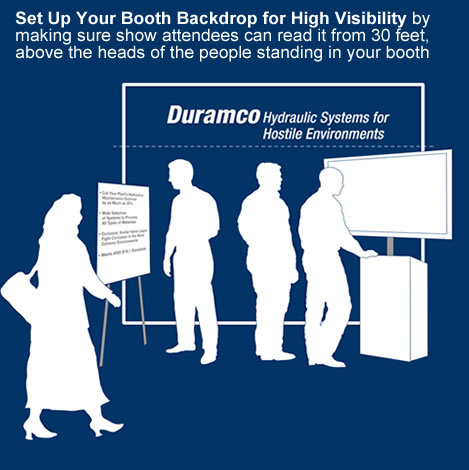
The key to specifying the design of your booth backdrop to your ad agency or marketing consultant is to keep it simple: If you are working in the standard 10' X 10' booth space, the only visual elements that should be featured on your backdrop are your company logo, a sales tagline describing your product or service, and some visual imagery, such as a photo of your product. Your company logo and sales tagline should be set in the top third of your booth backdrop, high enough so they can be seen over the head of someone who is standing in your booth (that is, about six feet in front of the backdrop).
When working in the standard 10' X 10' booth space, don’t place any other sales copy, like bulleted product benefits or features, below this top space on your backdrop, since any copy placed below the top third of your backdrop will be blocked from view by the people standing in the booth.
Instead, put these sales copy points on one or two smaller easel-mounted signs to be displayed close to the aisle at the front of your booth (see the graphic below). However, if you are working on a backdrop for a 10' X 20' or larger booth space, the extra booth space gives you more flexibility in your design options and allows you to place bulleted sales copy directly on your backdrop panels.
Backdrop sales tagline copy: Give some careful thought to the sales tagline you use on your backdrop. Your sales tagline should concisely answer any two of the following three questions, in 12 words or less:
• What is your product or service?
• Who is it for?
• What does it do for them?
The backdrop’s sales tagline is a brief, simple statement that mostly describes what your company sells. If you can, try to incorporate a few “benefit” words (such as “low-cost,” “intelligent”) into your tagline; if you can include your product’s main benefit, that’s even better, but not necessary.
Here are a few examples of booth backdrop sales taglines:
• One-Stop Environmental Mapping Services for Engineering Professionals
• The Low-Cost Newswire Alternative for Your Radio News Operation
• Intelligent Vision Systems for Robotic Assembly Operations
The only purpose of the sales tagline on your backdrop is to cut through the noise and confusion of the show by sparking your prospect’s attention as he or she walks down the aisle. The main selling job of your booth is handled by the other booth elements—the smaller signs at the front of your booth, and your sales video.
Small Booth Aisle Signs
To communicate your product’s most important benefits and features to show visitors who approach your boothat close range, place one or two easel-mounted signs by the aisle at the front of your booth. These signs give show visitors clear, telegraphic sales information on your product and, since they are mounted on free-standing easels, can be put anywhere, and angled in any direction, to catch the eye of as many show visitors as possible who walk by your booth.
Compared to other trade show deliverables, booth aisle signs are quick and inexpensive to produce. This is a big advantage, because it allows you to change the bulleted sales copy used on these signs to target your company’s product for each audience at each new trade show your company attends.
These signs can also be produced at any local sign shop, which means you can even re-work them during a show if necessary, to produce updated signs that present new, more effective sales benefit points as you discover them by listening to prospects at the show.
Sign options: Depending on your booth size and layout, you can use two signs, each measuring 16'' wide by 20'' high, or a single, larger sign, measuring 22'' wide by 30'' high.
Sales copy for aisle signs: Set about 3 to 6 bulleted copy points on each sign. Copy for this bullet text can be adapted from the bulleted copy you use in your brochures and other printed collateral.
Determine the best features and benefits to use in this copy by performing the sales copywriting exercises covered in the “Laundry List” writing exercise covered in a previous TMN. If your company’s product or service has an interesting visual presentation, you can also include it on your aisle sign in the form of a large, arresting photo or graphic.
Sales benefits: Here are some examples of sales benefits that would work well on aisle signs:
• Increase output in all of your assembly operations
• Reduce product defects before they reach QA
• Highest resolution imaging and fastest image processing in its class
Product features: Here are some examples of product features, written as aisle sign bullet points:
• Full-color, 12 megapixel CCD imaging display
• Ruggedized, mil-spec control unit for adverse shop floor environments
• Meets ANSI R15.06 requirements
If you already have bullet-point sales copy from your sales brochures and other printed marketing collateral, your ad agency or marketing consultant can readily adapt this copy for use on these aisle signs. Select the most important benefits and features from your sales materials, and boil these down to the fewest words possible.
Sign copy layout: If you’re using two smaller signs (16'' wide X 20'' high), you can make one sign the “benefits” sign, with 4 to 6 of your product’s top, bulleted sales benefits, and the other sign the “features,” sign, with 4 to 6 bullets listing your product’s top features. If you’re using a single, larger sign (22'' wide by 30'' high), you can combine benefits and features on the same sign, starting with 3 to 6 benefits at the top of the sign, and 3 to 6 features below.
Maximum readability: Clear visibility and impact are the key goals for booth aisle signs. Make sure that copy on these signs is readable from a distance of 8 feet—the average, centerline distance from where most show visitors walking down the center aisle of the show will see your booth.
To accomplish this, text used on these signs should be set at about 90 points (about 1-1/4'' inches tall). Sans-serif typefaces, such as Helvetica or Franklin Gothic, provide the best readability for all signage applications.
Sign design and production: Signs can be set either as black type on a plain white background, or (even better) in reversed white type on a dark color background. For signage applications, your ad agency or marketing consultant will have these signs output by a sign production shop on an inkjet printer and mounted on 1/4'' or thicker foam-core mounting board (also known as “Gatorfoam”).
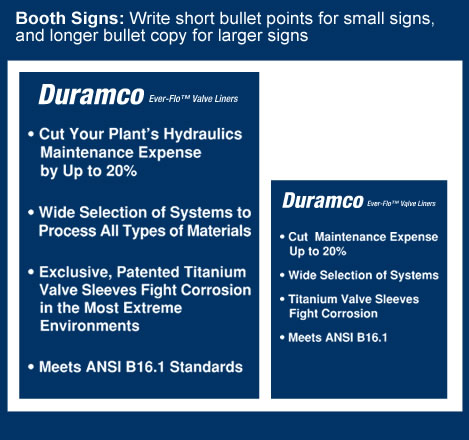
Sign placement: Arrange easel-mounted signs so they can be seen by the most people walking past your booth at the show.
The most common placement for these signs is about six inches away from the front edge of your booth, facing out from your booth. If you are using two signs, and space in your 10' X 10' booth is tight, then, facing the front of your booth, you can angle the right sign about 35º clockwise, and the left sign about 35º counter-clockwise (i.e., both signs angled slightly toward the inside of your booth), to give people more space to move around in your booth. This also gives these signs more side-facing exposure to site visitors walking down either side of the aisle in front of your booth.
To get the best visibility for signs in your booth, experiment with sign placement during the show. For example, if the flow of show attendees seems to be moving more in one direction than another, angle your signs to face this flow of foot traffic.
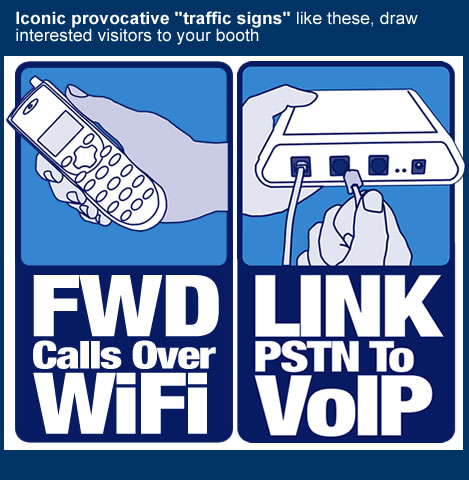
Easel mounting options: You can select from a variety of floor-standing easels (such as Stanrite easels, made by The Testrite Company of Newark, NJ) to display aisle-mounted signs in your booth. Most booths are supplied with a 2' X 6' folding table, so you can use a tabletop easel to mount one of your booth signs on the table, to save floor space in your booth.
Sign options for larger booth spaces: If you’re using a 10' X 20' or larger booth space, this larger space gives show visitors a clearer view of your entire backdrop, and allows them to see sales copy printed lower down on the backdrop. Because of this, you can incorporate bulleted-text sales copy directly on the lower portion of your booth backdrop, either as a part of the original backdrop design, or on separate, detachable signs, mounted with velcro on your backdrop, so that sales copy can be changed with each show, or for shows in new markets. Even for larger booth spaces, small, freestanding, text-bullet signs give your company’s sales message an added boost.
Trade Show Sales Video on Flat-Panel Display
A continuously-running sales video, shown on a 42'' flat-panel video display in your booth, is a powerful trade show marketing tool. This one- to two-minute video presentation, incorporating a professionally-narrated audio voiceover to give a letter-perfect sales presentation on your company’s product or service, draws visitors to your booth, and holds them there while they listen and watch.
There isn’t a more effective tool for drawing qualified prospects to your booth, and holding their attention. A booth video gives your sales reps the perfect opportunity to engage show visitors who are watching it, and frequently prompts show visitors to approach your sales reps on their own, after seeing and hearing a small portion of the video presentation.
Trade Show Video Production
Video is, in reality, an audio medium. People don’t really “watch” video, so much as listen to it. So the most important part of your booth’s sales video is its voiceover narration, which should be adapted from your company’s standard sales presentation, and should use all of the key sales benefits and product features your sales reps use in their own sales presentations.
Since the audio portion of the video carries most of the load of presenting and selling your product, the video portion of this project needn’t be an elaborate production. Often, all that is needed are some video clips of your product in use, mixed in with some still photos synchronized over your audio to reinforce your product’s key benefits, as shown in the graphic below . . .
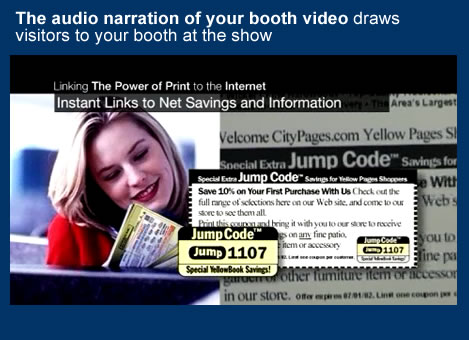
Animation, visual effects, and other eye candy always adds a “wow” factor, but don’t let these hold up your project, or get in the way of delivering your sales message. Any visual imagery, no matter how spectacular, will never be as effective as the content presented in your project’s spoken audio. Keep it simple, and put most of your effort into making sure that the voiceover track clearly presents and sells your product. Your ad agency, marketing consultant, or a video production company should be able to adapt your company’s sales presentation into a suitable trade show video.
Booth sales video execution: Trade show videos should be mastered on DVD to run as a continuous loop. Make four copies of your DVD—one for your booth, and three copies as backups, in case a glitch develops on any of your DVDs during the show. You may not think you’d need this many backups, but DVDs burned on a PC will sometimes break down after many hours of continuous playback in your booth (ask me how I know!). This seems to happen at the worst possible moment, so be prepared!
Production cost: A one- to two-minute trade show booth video costs from $2,500-$5,000 to produce, depending on how much original video needs to be shot for your project, and how much time is spent producing and tweaking the special effects used on it. When you consider the fact that there is no more effective marketing tool for drawing traffic to your booth and holding it there, a sales video more than justifies its production cost.
And once produced, your sales video has additional uses beyond your trade show. For example, with slight formatting changes, your video can be placed on your company’s Web site to give site visitors a quick walk-through of your product’s key sales benefits and features, and it can also be used by your company’s sales reps as a selling aid when making sales calls out in the field.
Renting a flat-panel display: Because they’re such effective trade show traffic builders, flat-panel displays are have become quite popular at trade shows. This wider use has dramatically cut rental prices for these units. A local audio/visual (A/V) rental company, can usually provide these units for less cost than the “official” audio visual supplier designated by the show sponsor. Rental cost for a 42'' flat-panel display, with a metal stand and DVD player, rented from a local A/V rental company, runs around $200-$350 per day, or less.
Focus on keeping your sales message bold, simple, and effective for each of these deliverables, use each of these booth elements for what they do best, and you’ll go a long way toward eliminating the doubt that your marketing presentation could have been more effective at drawing qualified prospects to your booth at the show.
And by concentrating on clear, forceful presentation that draws qualified booth traffic, you’ll do what marketing managers are supposed to do: Support your company’s sales team by making your next trade show project a sales-driving success for your company.
Comments? Questions? Send them to me at: eric@realmarkets.net
_____________________________________________________________
Eric Gagnon (eric@realmarkets.net), is president of GAA, a sales and business development consulting firm, and is the author of The Marketing Manager’s Handbook, the master study guide for the Business Marketing Association’s Marketing Skills Assessment, Skill Builder, and Certification (MSA/B/C) programs.
For more information on The Marketing Manager’s Handbook, available to BMA members at a special discount, link to:
http://www.businessmarketinginstitute.com/book.html
_____________________________________________________________
Test, Train, and Build Your B2B Marketing Skills for Better Sales Success: BMA Announces New Assessment, Training, and Certification for B2B Marketing Managers
For more information on the new BMA Marketing Skills Assessment, Skill Building and Certification (MSA/B/C) training and professional development program, visit http://www.businessmarketinginstitute.com
